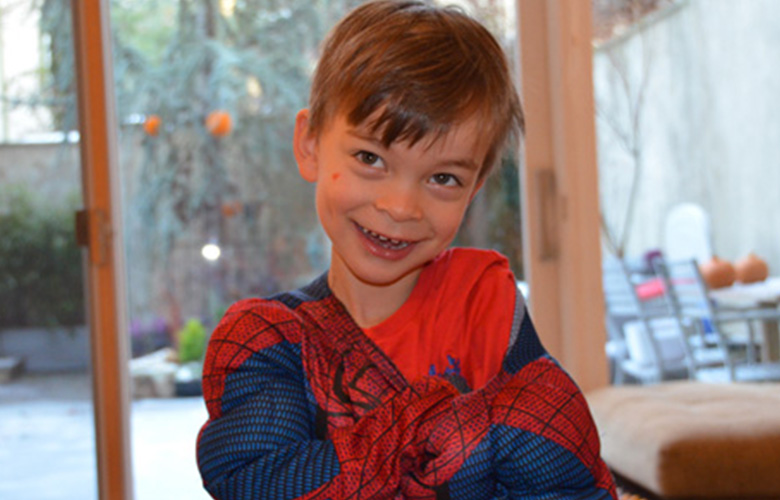
Spider Man changing out of his costume after saving our dinner.
When he was 4-years-old our son Jack loved to play superheroes.
One day we were playing, and he was dressed in his Spider Man outfit—a full body suit complete with muscles and mask. I was Batman wearing a cape and kid’s costume.
The dastardly situation I told Spider Man we were facing was that bad guys were trying to take our dinner…
Jack: “Don’t worry Daddy, I know what to do.”
[Jack ran to the kitchen, got a spatula and went in the corner.]
Me: “Jack, what are you doing?”
Jack: “I’m making pancakes for them. If they’re trying to take our dinner, they must be hungry.”
What awesome perspective. I was thinking we’d capture the bad guys or even put them in jail.
Thankfully, I didn’t blurt out anything that would have changed Jack’s view of the situation.
We won’t be able to preserve Jack’s innocence forever, but he absorbs so much of what we say and do, that we have an opportunity to purposefully do things that we hope will help mold Jack into a caring and compassionate person.
With that in mind, my wife and I have often thought about how to make sure our son is grateful, kind and compassionate. We have no idea what we’re doing, but here are some ideas and related thoughts. Half are new and half I’ve posted here before…
-
Help develop your child’s identity as a caring person. Rather than telling your child “That was a kind thing to do,” say, “You’re such a kind person.”
-
Model the behavior you’d like to see. No matter how much we talk about being kind or the right way to act, kids learn by watching the little things we actually do.
-
Listen. It’s easy for us to tell our kids they should listen, and then cut them off when they’re too chatty. If we want our kids to be great listeners, make sure we’re great listeners.
-
Use kind words and a kind tone – I try hard to be aware of when I’m frustrated and then pause before speaking. That has reduced the likelihood that I’ll use a tone of voice that I wouldn’t want our son to use. Once I started focusing on this, I became much better and our son did too.
-
Emphasize the importance of being kind. We regularly talked to our son about the importance of trying to do something (grit) and the importance of being happy. Just as important is to regularly talk about being kind.
-
At dinner we discuss acts of kindness that each of us saw during the day. As we’ve been doing this, I’ve noticed that our son has begun doing many of the things we mention in conversation.
-
Practice gratitude. Grateful kids (and adults) are more likely to be kind and happy. Talking about what you’re thankful for can be a daily ritual at dinner, bedtime or in a journal. A fantastic thing about gratitude is that scientific research shows that something as simple as keeping a gratitude journal for a couple minutes a day increases happiness.
-
Do something about your gratitude. At Ronald McDonald Camp we did Warm and Fuzzies. These were short notes of appreciate we’d write to others at the camp. Why not have our kids write a quick, spontaneous note anytime someone does something nice?
-
I’d also like our son to participate in writing at least one planned thank you note a week.
Your child can play a role in choosing recipients. We’re planning to make sure we include the people who are often taken for granted — the bus driver, mail carrier, trash collector, cleaning person (if you have one) and others. This helps ensure that our child realizes and appreciates what everyone does for him.
Include a picture and your note will be a huge hit.
-
My friend Tony and his daughter Maya were driving through the city and passed a homeless person. Maya asked, “Why is that man standing on the corner with a sign?” Tony responded that the man was homeless and asking for food. Maya asked, “Why don’t we get him food?” That made Tony wonder, “Why didn’t they?”
Tony was embarrassed that it took his daughter to help him realize how he had been overlooking the homeless (probably from spending so much time in the city).
Tony’s lack of attention could have sent a message to his daughter. Fortunately, she brought him back to the humanity of the situation, so they could provide some food and Tony could set the example he wanted to set.
This changed my thinking as well. I try to carry around some extra food to give to homeless people we see around the city. First and foremost, it must be awful to be homeless and I’m sure the food goes a long way. It also sets an example for our son–that we shouldn’t ignore people in need.
I’ve heard of other families making food or toiletry care packages for the homeless and even including nice notes from the kids, which I’m sure brightens someone’s day.
Everyone matters, and we want our kids to know that.
-
During the holidays my cousin takes her children to a store to pick out and buy a gift for a child who might not get many gifts. This year, instead of getting 8 gifts for Hanukkah, her kids got 7 and the 8th gift was one they picked out for someone else. Toys for Tots is a great recipient of these random acts of kindness.
My wife found an opportunity for us to get a gift for a child staying at a local hospital. We knew the kid’s age and interests, so we could go to the store with our son and let Jack think about and pick out a gift that the specific child would enjoy.
-
We’ve been talking to our son about how he is lucky to have so many toys and that many kids aren’t as lucky. We are working with him to choose toys to give to kids who are less fortunate. I say “working with him,” because he agreed he should share some toys but only offered the two small broken toys that he never uses.
(By the way if you’re interested in donating stuff, you can check out this guide of where to donate your stuff.)
-
Find a chance to help neighbors with projects – shoveling snow, raking leaves, etc.
-
Have your kid say “hi” to everyone. We told our son that people smile and feel good when he says “hello.” Now he is always saying hello to people on the street and people love it. Even people in a bad mood smile when he says “hello.”
-
Every night at bedtime we talk about what we’re thankful for and our favorite parts of the day.
-
Participate in service with your kids. We’ve packed and delivered food to people who needed it, which our son loved.
-
Give stuff away. At Halloween our son loved giving out candy. Jack even chased down adults clearly returning from work to give them candy. Even the people who seemed to be in a bad mood smiled. And, Jack learned the joy of giving. Set up a free lemonade stand or find something else to give out. Practice giving.
-
Special Treat Friday — every Friday you and your kids could “cook” something you can give to someone else…a fun activity with a focus on giving.
-
I read about a teacher who got her first graders involved in random acts of kindness by having her class collectively perform 100 acts of kindness over a 2-week period. The class recorded each act on a small heart and organized the hearts into a collage. Perhaps you can do this at home as a way to get your kids excited about and discussing acts of kindness.
-
Make Cards. Valentine’s or holiday cards for seniors. Cards or baskets to take to police or fire stations. Get well cards for hospitals.
-
I mentioned to our friend John that I was concerned with how many toys our son has. As part of a large, loving family, Jack gets lots of toys. Even when we ask people not to bring presents to Jack’s birthday parties, people bring gifts (by the way, I completely understand this).
John said he used to tell his children’s friends to bring a gift to be donated to a hospital. This allows people to still bring gifts, and your child’s birthday becomes an opportunity to help others.
There’s also an opportunity to engage your children in this activity. Choose the nonprofit together. Then, if you can, bring the gifts to the nonprofit. We plan to go to Cradles to Crayons with Jack one day so Jack can see the gifts get packaged up for kids who need them.
-
Let your kids tell you what they love about someone and decorate a box or bag and put notes with your kids’ thoughts inside the box/bag. Then make someone’s day with the gift. We just made one of these boxes at a party for one of our son’s friends.
Along these lines, you and your child can create a “What I love about you” book for someone.
Here’s another cool craft of appreciation. This one from Tutus and Tea Parties.

-
I saw a neat project, where kids created decorations for cans at a hunger pantry. What a great way to make someone smile. (From Curly Birds blog.)

- Teacher Helen Mrosla had a great kindness idea for the classroom and our families.
Give each member of your family, team, class or group a piece of paper with the name of every group member on the piece of paper. Tell each group member to “write what you appreciated about each fellow group member next to the person’s name” (or you can give out notecards and instruct everyone to “write what you appreciate about each group member on a separate notecard”). The leader collects all of the sheets/cards.
All of the comments are organized so each person gets a page (or the cards) with all of the positive comments about them.
Helen discovered that her students cherished these sheets so much that the students kept them and still talked about them a decade later. The parents of one student told Helen that their son took the paper with him when he was deployed and kept it with him the entire time.
People don’t hear how special they are often enough. This act of kindness exercise is a simple way to appreciate others in a lasting and touching way.
-
Anna at The Imagination Tree has made an awesome modification to Elf on the Shelf. Her elves are in the house to spread holiday spirit. Every day the kids can find the elves in a different place with suggestions on things they can do that day to be in the holiday spirit.

Things we’re trying
Things we think are worth trying (but haven’t yet)
Want more positivity in your Facebook news feed? If you enjoyed this post, please consider clicking this link and liking my Facebook page. You’ll get inspirational stories, good news and a focus on the positive. (About one post a week.) Thanks!
If you enjoyed this post, I think you’ll also like these two:
102 Random Acts of Kindness that will make you an everyday hero.
Be Happy: 46 Proven Techniques to Improve Your Happiness and One Way to Get More Sex.





